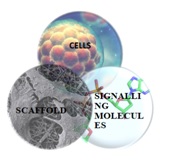Role of tissue engineering in oral & maxillofacial surgery – a review
Abstract
Tissue engineering can be defined as the “reconstitution of tissue and organs, in vitro for use as model systems in basic and applied research, or for use as grafts to replace damaged or diseased body parts or body functions”. Biomaterials have been used as replacement tissues and grafts have been used to reconstruct defects in craniofacial region till Uristmade the first attempt of producing exogenous bone with the help of bone morphogenetic proteins. The success of tissue engineering over the field of all transplantation is that conceptually a three-dimensional functional tissue is designed. This field has become a boon to the Cranio Maxillofacial surgeons and has provided them with a supplement to existing treatment for reconstruction of Oral & Craniofacial region. The purpose of this article is to present an overview of the various uses of tissue engineering in the field of Oral and Maxillofacial Surgery.
Downloads
References
Bell E. Tissue engineering: a perspective. J Cell Biochem. 1991 Mar;45(3):239-41. DOI: https://doi.org/10.1002/jcb.240450302.
Urist MR, Strates BS. Bone morphogenetic protein. J Dent Res. 1971 Nov-Dec;50(6):1392-406. DOI: https://doi.org/10.1177%2F00220345710500060601.
Melek LN. Tissue engineering in oral and maxillofacial reconstruction. Tanta Dental Journal. 2015 Sep 1;12(3):211-23.
Kasper FK, Melville J, Shum J, Wong M, Young S. Tissue engineered prevascularized bone and soft tissue flaps. Oral and Maxillofacial Surgery Clinics. 2017 Feb 1;29(1):63-73.
Schnaper HW, Kleinman HK. Regulation of cell function by extracellular matrix. PediatrNephrol. 1993 Feb;7(1):96-104.
Yang S, Leong KF, Du Z, et al. The design of scaffolds for use in tissue engineering. Part I. Traditional factors. Tissue Eng. 2001 Dec;7(6):679-89. DOI: https://doi.org/10.1089/107632701753337645.
Burg KJ, Porter S, Kellam JF. Biomaterial developments for bone tissue engineering. Biomaterials. 2000 Dec;21(23):2347-59.
Costello BJ, Shah G, Kumta P, et al. Regenerative medicine for craniomaxillofacial surgery. Oral MaxillofacSurg Clin North Am. 2010 Feb;22(1):33-42. doi: https://doi.org/10.1016/j.coms.2009.10.009.
Fraser JK, Zhu M, Wulur I, et al. Adipose-derived stem cells. Methods Mol Biol. 2008;449:59-67. doi: https://doi.org/10.1007/978-1-60327-169-1_4.
Takahashi K, Tanabe K, Ohnuki M, et al. Induction of pluripotent stem cells from adult human fibroblasts by defined factors. Cell. 2007 Nov 30;131(5):861-72. DOI: https://doi.org/10.1016/j.cell.2007.11.019.
Atala A, Kasper FK, Mikos AG. Engineering complex tissues. Sci Transl Med. 2012 Nov 14;4(160):160rv12. doi: https://doi.org/10.1126/scitranslmed.3004890.
Warnke PH, Springer IN, Wiltfang J, et al. Growth and transplantation of a custom vascularised bone graft in a man. Lancet. 2004 Aug 28-Sep 3;364(9436):766-70.
Heliotis M, Lavery KM, Ripamonti U, et al. Transformation of a prefabricated hydroxyapatite/osteogenic protein-1 implant into a vascularised pedicled bone flap in the human chest. Int J Oral Maxillofac Surg. 2006 Mar;35(3):265-9. Epub 2005 Oct 28.
Lee J, Sung HM, Jang JD, et al. Successful reconstruction of 15-cm segmental defects by bone marrow stem cells and resected autogenous bone graft in central hemangioma. J Oral Maxillofac Surg. 2010 Jan;68(1):188-94. doi: https://doi.org/10.1016/j.joms.2009.08.031.
Izumi K, Terashi H, Marcelo CL, et al. Development and characterization of a tissue-engineered human oral mucosa equivalent produced in a serum-free culture system. J Dent Res. 2000 Mar;79(3):798-805. DOI: https://doi.org/10.1177%2F00220345000790030301.
Kim RY, Bae SS, Feinberg SE. Soft Tissue Engineering. Oral MaxillofacSurg Clin North Am. 2017 Feb;29(1):89-104. doi: https://doi.org/10.1016/j.coms.2016.08.007.
Khmaladze A, Ganguly A, Kuo S, Raghavan M, Kainkaryam R, Cole JH, et al. Tissue-engineered constructs of human oral mucosa examined by raman spectroscopy. Tissue Eng Part C Methods. 2013;19:299–306.
Joraku A, Sullivan CA, Yoo J, et al. In-vitro reconstitution of three-dimensional human salivary gland tissue structures. Differentiation. 2007 Apr;75(4):318-24.
Evans GR, Brandt K, Katz S, et al. Bioactive poly(L-lactic acid) conduits seeded with Schwann cells for peripheral nerve regeneration. Biomaterials. 2002 Feb;23(3):841-8.
Pfister LA1, Papaloïzos M, Merkle HP, et al. Nerve conduits and growth factor delivery in peripheral nerve repair. J PeripherNerv Syst. 2007 Jun;12(2):65-82. DOI: https://doi.org/10.1111/j.1529-8027.2007.00125.x
Egusa H, Sonoyama W, Nishimura M, et al. Stem cells in dentistry--Part II: Clinical applications. J Prosthodont Res. 2012 Oct;56(4):229-48. doi: https://doi.org/10.1016/j.jpor.2012.06.001.
Abou Neel EA, Chrzanowski W, Salih VM, et al. Tissue engineering in dentistry. J Dent. 2014 Aug;42(8):915-28. doi: https://doi.org/10.1016/j.jdent.2014.05.008.
He X, Dziak R, Mao K, et al. Integration of a novel injectable nano calcium sulfate/alginate scaffold and BMP2 gene-modified mesenchymal stem cells for bone regeneration. Tissue Eng Part A. 2013 Feb;19(3-4):508-18. doi: https://doi.org/10.1089/ten.tea.2012.0244.
Das A, Segar CE, Hughley BB, et al. The promotion of mandibular defect healing by the targeting of S1P receptors and the recruitment of alternatively activated macrophages. Biomaterials. 2013 Dec;34(38):9853-62. doi: https://doi.org/10.1016/j.biomaterials.2013.08.015.
Zou D, Zhang Z, He J, et al. Repairing critical-sized calvarial defects with BMSCs modified by a constitutively active form of hypoxia-inducible factor-1α and a phosphate cement scaffold. Biomaterials. 2011 Dec;32(36):9707-18. doi: https://doi.org/10.1016/j.biomaterials.2011.09.005.
Ansari S, Moshaverinia A, Pi SH, Han A, Abdelhamid AI, Zadeh HH. Functionalization of scaffolds with chimeric anti-BMP-2 monoclonal antibodies for osseous regeneration. Biomaterials. 2013; 34: 10191- 10198.
Depprich R, Handschel J, Wiesmann HP, Jäsche-Meyer J, Meyer U. Use of bioreactors in maxillofacial tissue engineering. British Journal of Oral and Maxillofacial Surgery. 2008 Jul 1;46(5):349-54.



 OAI - Open Archives Initiative
OAI - Open Archives Initiative


